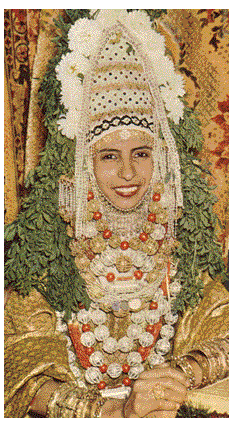|
This tight-knit community was recently thrust onto the front pages of newspapers the world over after it was revealed that, in all likelihood, the Israeli government participated in the kidnapping of its young. But few, it seems, were familiar with the extraordinary history of
The Jews of Yemen
Part I of a Series by Nehama C. Nahmoud
From antiquity (i.e., the times of Jerusalem's First Holy Temple) well into the Middle Ages, the Mediterranean and Middle Eastern
countries were the center of civilization in the world, while Northern
and Eastern Europe were large, untouched, heavily forested expanses
inhabited by wild animals and equally wild and barbaric primitive
tribes.
Yemen, far from being an out-of-the-way spot, was a central point on an
important trade route between India, Africa, and the other Middle
Eastern Mediterranean countries. As in New York and Marseilles today,
merchant ships sailed in and out of Yemen's ports constantly. Camel
caravans came and went by land routes through the Arabian desert.
America was discovered because Columbus was looking for a direct sea
route from Spain to India. But why was India so essential to this
period?
India was actually the backbone of the medieval international economy,
since many of its products were necessities in the daily lives of the
people of the epoch. In an age when there were no refrigerators, they
used pepper and spices to preserve meat (and to reduce its stench) and
other foods. Medicines came from plants (as many still do today) and
India and the Middle East were then the prime sources of these herbs.
"Well dressed" meant "colorful" in those days and, not having our
synthetic dyes, they turned to natural sources, which came mostly from
India and Muslim countries.
Oriental and Sephardic Jews were very active in this commerce, which
reached its peak in the 12th century as far as their participation was
concerned. They were merchants and they served as intermediaries between
the East and Europe, Iran and Egypt, Iraq, Palestine, Syria, and the
countries of the Western Mediterranean: Spain, Morocco, Tunisia, Libya,
and the islands of Majorca (now Spanish) and Sicily (now Italian).
THE BEGINNING
There are several ancient legends and modern theories about the arrival
of Jews in Yemen.
Most with a cursory knowledge of the Torah, are aware of the visit of
the Queen of Shvah (Sheba) to King Shlomo (Solomon). But there
is a question that has never been answered: Where exactly did she come
from? The Ethiopian royal family, living just across a hannel from
Yemen, always claimed descent from the Queen of Shvah. The king's
official title is the "Lion of Judah" for this reason.
However, the Yemenites have a legend that posits that when the Queen of
Shvah returned from her visit to Shlomo, she brought back
educated Jews from the Holy Land with the goal of educating her child,
thus establishing the first Jewish presence in the Arabian peninsula,
which includes Yemen.
The modern view is that, as Jews were always merchants and traders, they
established a commercial outpost in Yemen even before the destruction of
the First Holy Temple, building the framework of a Jewish community
there.
When the first rumblings of impending trouble with Babalonia were felt,
it's believed that more Jews made their way to Yemen and then, at the
time of the invasion itself, a very large wave of immigration took
place. It is told that at the time of the destruction of the First Holy
Temple some 8,000 Kohanim (members of the priestly caste) escaped
and joined a settlement in the Arabian peninsula. Indeed, the prophet
Jeremiah (38:2) repeatedly advised Jewry to escape to the region for
safety.
Among the exiles were all classes of Jewry: Kohanim, Levi'im,
and ordinary Yisraelim, as well as converts and slaves. Even today,
Jewish residents of Yemen's capital city of San'a say that residents of
some of the hamlets in Yemen's different districts are descended from
converts and slaves of that era.
The Levites, too, settled in particular towns, modeling their new
communities after a similar caste structure that existed in ancient
Israel. In fact, there were areas in Yemen inhabited only by people with
the surname "Levi" (or HaLevi).
During the subsequent Persian rule -- the era of Queen Esther,
protaganist of the Purim story -- many Jews immigrated to to Yemen from
Persian-dominated Babylonia, as well. Still another joined the Yemenite
community follwing the Bar Kochba rebellion, after the destruction of
the Second Holy Temple.
Next issue: The Jewish Kings of Yemen
THE YEMENITE GOLUS
(exile) is possibly the most exotic story in the annals of Jewish history. The first question that comes to
mind is: How -- and why -- did Jews get to such a backwater as Yemen?
story in the annals of Jewish history. The first question that comes to
mind is: How -- and why -- did Jews get to such a backwater as Yemen?
Nehama C. Nahmoud is the author of several works on Oriental, Middle Eastern and Sephardic Jews. She lives in Jerusalem.